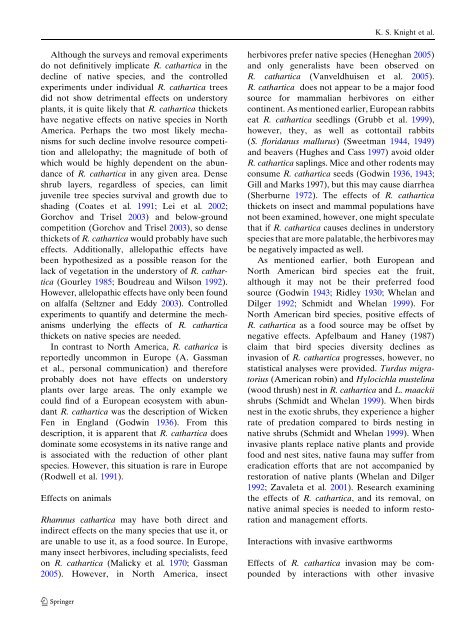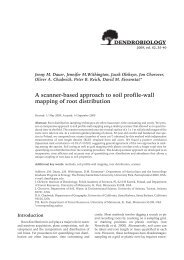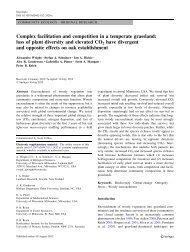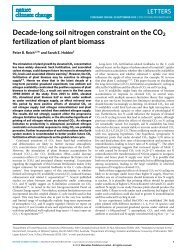Ecology and ecosystem impacts of Rhamnus cathartica
Ecology and ecosystem impacts of Rhamnus cathartica
Ecology and ecosystem impacts of Rhamnus cathartica
Create successful ePaper yourself
Turn your PDF publications into a flip-book with our unique Google optimized e-Paper software.
Although the surveys <strong>and</strong> removal experiments<br />
do not definitively implicate R. <strong>cathartica</strong> in the<br />
decline <strong>of</strong> native species, <strong>and</strong> the controlled<br />
experiments under individual R. <strong>cathartica</strong> trees<br />
did not show detrimental effects on understory<br />
plants, it is quite likely that R. <strong>cathartica</strong> thickets<br />
have negative effects on native species in North<br />
America. Perhaps the two most likely mechanisms<br />
for such decline involve resource competition<br />
<strong>and</strong> allelopathy; the magnitude <strong>of</strong> both <strong>of</strong><br />
which would be highly dependent on the abundance<br />
<strong>of</strong> R. <strong>cathartica</strong> in any given area. Dense<br />
shrub layers, regardless <strong>of</strong> species, can limit<br />
juvenile tree species survival <strong>and</strong> growth due to<br />
shading (Coates et al. 1991; Lei et al. 2002;<br />
Gorchov <strong>and</strong> Trisel 2003) <strong>and</strong> below-ground<br />
competition (Gorchov <strong>and</strong> Trisel 2003), so dense<br />
thickets <strong>of</strong> R. <strong>cathartica</strong> would probably have such<br />
effects. Additionally, allelopathic effects have<br />
been hypothesized as a possible reason for the<br />
lack <strong>of</strong> vegetation in the understory <strong>of</strong> R. <strong>cathartica</strong><br />
(Gourley 1985; Boudreau <strong>and</strong> Wilson 1992).<br />
However, allelopathic effects have only been found<br />
on alfalfa (Seltzner <strong>and</strong> Eddy 2003). Controlled<br />
experiments to quantify <strong>and</strong> determine the mechanisms<br />
underlying the effects <strong>of</strong> R. <strong>cathartica</strong><br />
thickets on native species are needed.<br />
In contrast to North America, R. catharica is<br />
reportedly uncommon in Europe (A. Gassman<br />
et al., personal communication) <strong>and</strong> therefore<br />
probably does not have effects on understory<br />
plants over large areas. The only example we<br />
could find <strong>of</strong> a European <strong>ecosystem</strong> with abundant<br />
R. <strong>cathartica</strong> was the description <strong>of</strong> Wicken<br />
Fen in Engl<strong>and</strong> (Godwin 1936). From this<br />
description, it is apparent that R. <strong>cathartica</strong> does<br />
dominate some <strong>ecosystem</strong>s in its native range <strong>and</strong><br />
is associated with the reduction <strong>of</strong> other plant<br />
species. However, this situation is rare in Europe<br />
(Rodwell et al. 1991).<br />
Effects on animals<br />
<strong>Rhamnus</strong> <strong>cathartica</strong> may have both direct <strong>and</strong><br />
indirect effects on the many species that use it, or<br />
are unable to use it, as a food source. In Europe,<br />
many insect herbivores, including specialists, feed<br />
on R. <strong>cathartica</strong> (Malicky et al. 1970; Gassman<br />
2005). However, in North America, insect<br />
123<br />
herbivores prefer native species (Heneghan 2005)<br />
<strong>and</strong> only generalists have been observed on<br />
R. <strong>cathartica</strong> (Vanveldhuisen et al. 2005).<br />
R. <strong>cathartica</strong> does not appear to be a major food<br />
source for mammalian herbivores on either<br />
continent. As mentioned earlier, European rabbits<br />
eat R. <strong>cathartica</strong> seedlings (Grubb et al. 1999),<br />
however, they, as well as cottontail rabbits<br />
(S. floridanus mallurus) (Sweetman 1944, 1949)<br />
<strong>and</strong> beavers (Hughes <strong>and</strong> Cass 1997) avoid older<br />
R. <strong>cathartica</strong> saplings. Mice <strong>and</strong> other rodents may<br />
consume R. <strong>cathartica</strong> seeds (Godwin 1936, 1943;<br />
Gill <strong>and</strong> Marks 1997), but this may cause diarrhea<br />
(Sherburne 1972). The effects <strong>of</strong> R. <strong>cathartica</strong><br />
thickets on insect <strong>and</strong> mammal populations have<br />
not been examined, however, one might speculate<br />
that if R. <strong>cathartica</strong> causes declines in understory<br />
species that are more palatable, the herbivores may<br />
be negatively impacted as well.<br />
As mentioned earlier, both European <strong>and</strong><br />
North American bird species eat the fruit,<br />
although it may not be their preferred food<br />
source (Godwin 1943; Ridley 1930; Whelan <strong>and</strong><br />
Dilger 1992; Schmidt <strong>and</strong> Whelan 1999). For<br />
North American bird species, positive effects <strong>of</strong><br />
R. <strong>cathartica</strong> as a food source may be <strong>of</strong>fset by<br />
negative effects. Apfelbaum <strong>and</strong> Haney (1987)<br />
claim that bird species diversity declines as<br />
invasion <strong>of</strong> R. <strong>cathartica</strong> progresses, however, no<br />
statistical analyses were provided. Turdus migratorius<br />
(American robin) <strong>and</strong> Hylocichla mustelina<br />
(wood thrush) nest in R. <strong>cathartica</strong> <strong>and</strong> L. maackii<br />
shrubs (Schmidt <strong>and</strong> Whelan 1999). When birds<br />
nest in the exotic shrubs, they experience a higher<br />
rate <strong>of</strong> predation compared to birds nesting in<br />
native shrubs (Schmidt <strong>and</strong> Whelan 1999). When<br />
invasive plants replace native plants <strong>and</strong> provide<br />
food <strong>and</strong> nest sites, native fauna may suffer from<br />
eradication efforts that are not accompanied by<br />
restoration <strong>of</strong> native plants (Whelan <strong>and</strong> Dilger<br />
1992; Zavaleta et al. 2001). Research examining<br />
the effects <strong>of</strong> R. <strong>cathartica</strong>, <strong>and</strong> its removal, on<br />
native animal species is needed to inform restoration<br />
<strong>and</strong> management efforts.<br />
Interactions with invasive earthworms<br />
K. S. Knight et al.<br />
Effects <strong>of</strong> R. <strong>cathartica</strong> invasion may be compounded<br />
by interactions with other invasive






